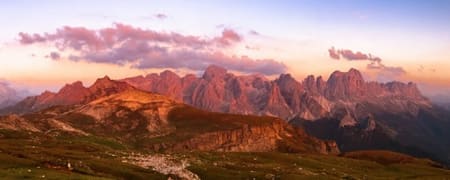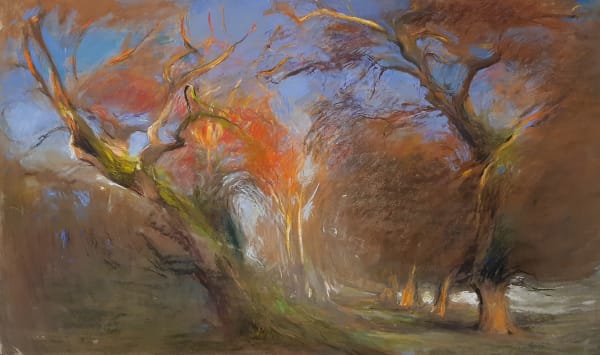
ERNST NEPO (Ernst Nepomucky) 1895, Dubá-1971, Innsbruck
Provenance
Artist’s heirs; private collection.
After attending the School of Applied Arts in Teplitz from 1909 to 1913, Ernst Nepo studied at the School of Applied Arts in Vienna from 1913 to 1914. During the First World War, he served in the Kaiserjäger – Tyrolean Rifle Regiment – in Galicia (Eastern Europe) and on the southern front. After the war he settled in Mühlau, a borough of Innsbruck. It was here, in 1920, that the artist produced the work presented here. The historic capital of Tyrol, Innsbruck, known as the “Pearl of the Dolomites”, offers unparalleled views of the mountain range (FIG. 1).

FIG. 1 - Tramonto sulle Dolomiti, Innsbruck
In this work the range is painted using several successive planes in perspective. Starting from the foreground hills, the gaze continues to reach the second layer where some snow-covered peaks are characterized by subtle bright touches of pale turquoise.
The attention quickly shifts to settle on the clouds in the sky. Dense and full-bodied, they occupy a good deal of the painted surface, designing a sort of continuation of the mountains’ profile. The palette is very bold, the rays of the sun have totally transformed the natural colours of the landscape, tingeing it with numerous shades of red and orange.
The natural landscape has been interiorized by the painter and yielded in an artistic form which shares many of the characteristics of Symbolist landscapes, or even better, that particular artistic trend which affirmed itself at the end of the nineteenth century and took the name “landscape of the soul”. In fact, this work is devoid of those evocative enigmatic messages typical of Symbolist landscapes, but it can be read as an artistic internalization of a landscape very dear to the artist. A new type of landscape, not naturalistic, not a simple reproduction of a natural glimpse but a mystical-philosophical expression, by virtue of the direct and profound link between nature and human feelings. These were the assumptions which would lead Ernst Nepo to approach the Secessionist and Expressionist tendencies.
In 1925, he co-founded the group of artists “Wage” and only a couple of years later became part of theVienna Secession. It was thanks to this connection that his works of this period were so strongly influenced by Giovanni Segantini and Egon Schiele.
After this first period closer to Secessionist and Expressionist currents, Nepo became fascinated by Neue Sachlichkeit, an artistic movement born in Germany at the end of the Great War as a reaction to Expressionism. The movement came to an end with the rise of the Third Reich, which termed it “Degenerate Art” (Entartete Kunst).
Despite the fact that not many of his works are typical of the Neue Sachlichkeit movement, Ernst Nepo is considered by international critics to be one of the most incisive exponents of this movement in Tyrol. The general public knows him above all for his portraits, his numerous frescoes, mosaics, and paintings on glass. His works are also kept at theTyrolean State Museumin Innsbruck, the University of Applied Arts collection in Vienna, and theMuseion – Museum of Modern and Contemporary Art – in Bozen (Bolzano).
Join the mailing list
Subscribe to our newsletter to receive all the news about exhibitions, fairs and new acquisitions!

